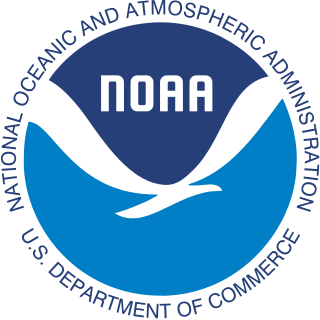
The National Oceanic and Atmospheric Administration is an American scientific agency within the United States Department of Commerce that focuses on the conditions of the oceans, major waterways, and the atmosphere.

The Consumer Technology Association (CTA) is a standards and trade organization representing more than 2,200 consumer technology companies in the United States. CTA works to influence public policy, holds events such as CES and CES Asia, conducts market research, and helps its members and regulators implement technical standards. CTA is led by President and CEO Gary Shapiro.
Defence Science and Technology is part of the Australian Department of Defence dedicated to providing science and technology support for Australia's defence and national security needs. It is Australia's second largest government-funded science organisation after the CSIRO. The agency's name was changed from Defence Science and Technology Organisation (DSTO) to Defence Science and Technology on 1 July 2015.
Ita or ITA may refer to :
United States federal research funders use the term cyberinfrastructure to describe research environments that support advanced data acquisition, data storage, data management, data integration, data mining, data visualization and other computing and information processing services distributed over the Internet beyond the scope of a single institution. In scientific usage, cyberinfrastructure is a technological and sociological solution to the problem of efficiently connecting laboratories, data, computers, and people with the goal of enabling derivation of novel scientific theories and knowledge.

The Instituto Tecnológico de Aeronáutica is an institution of higher education and advanced research with emphasis in aerospace science and technology maintained by the Brazilian Air Force. It is located in São José dos Campos, Brazil. ITA is rated as one of the top and most prestigious engineering schools in Brazil.
A virtual enterprise (VE) is a temporary alliance of businesses that come together to share skills or core competencies and resources in order to better respond to business opportunities, and whose cooperation is supported by computer networks.

The Army Research Laboratory (ARL) is the U.S. Army's corporate research laboratory. ARL is headquartered at the Adelphi Laboratory Center (ALC) in Adelphi, Maryland. Its largest single site is at Aberdeen Proving Ground, Maryland. Other major ARL locations include Research Triangle Park, North Carolina, White Sands Missile Range, New Mexico, Orlando, Florida, and NASA's Glenn Research Center, Ohio and Langley Research Center, Virginia.
The Network Science Collaborative Technology Alliance is a collaborative research alliance funded by the US Army Research Laboratory (ARL) and focused on fundamental research on the critical scientific and technical challenges that emerge from the close interdependence of several genres of networks such as social/cognitive, information, and communications networks. The primary goal of the NS CTA is to deeply understand the underlying commonalities among these intertwined networks, and, by understanding, improve our ability to analyze, predict, design, and influence complex systems interweaving many kinds of networks.

The National Institute for Space Research is a research unit of the Brazilian Ministry of Science, Technology and Innovation, whose main goals are fostering scientific research and technological applications and qualifying personnel in the fields of space and atmospheric sciences, space engineering, and space technology. While INPE is the civilian research center for aerospace activities, the Brazilian Air Force's General Command for Aerospace Technology is the military arm. INPE is located in the city of São José dos Campos, São Paulo.

The Indian Institute of Food Processing Technology (IIFPT) is a pioneer Educational and R&D Institution under the Ministry of Food Processing Industries (MoFPI). IIFPT has a 15-acre campus.
The service-oriented computing environment (SORCER) is a distributed computing platform implemented in Java. It allows writing network-programs that operate on wrapped applications (services) to spread across the network. SORCER is often utilized in scenarios similar to those where grids are used in order to run parallel tasks.
Boeing UK is the UK subsidiary of Boeing, an American multinational corporation that designs, manufactures, and sells airplanes, rotorcraft, rockets and satellites.
In 2017, U.S. Army Research Laboratory (ARL) established the Internet of Battle Things (IoBT) Collaborative Research Alliance (CRA), a research effort that developed foundations of IoBT in the context of future Army operations. The research alliance consisted of private sector and government researchers working jointly to address military challenges in internet-connected, complex battlefields. IoBT is related to the use of robots in battle.
The Cognition and Neuroergonomics (CaN) Collaborative Technology Alliance was a research program initiated, sponsored and partly performed by the U.S. Army Research Laboratory. The objective of the program was to “conduct research and development leading to the demonstration of fundamental translational principles of the application of neuroscience-based research and theory to complex operational settings. These principles will guide the development of technologies that work in harmony with the capabilities and limitations of the human nervous system.”
Cyber Security Collaborative Research Alliance (CSCRA) was a research program initiated and sponsored by the US Army Research Laboratory (ARL). The objective of the program was “to develop a fundamental understanding of cyber phenomena, including aspects of human attackers, cyber defenders, and end users, so that fundamental laws, theories, and theoretically grounded and empirically validated models can be applied to a broad range of Army domains, applications, and environments.”

The Princeton University Department of Chemistry is an academic department at Princeton University. Founded in 1795, it is one of the oldest departments of chemistry in the country and is consistently funded by grants from the National Science Foundation and the National Institutes of Health. In 2010, the department moved to its new location, the Frick Chemistry Laboratory. The department oversees the undergraduate, graduate, and post-doctoral programs in chemistry, as well as a number of research centers and initiatives at the university.
Multi-Scale Multidisciplinary Modeling of Electronic Materials (MSME) Collaborative Research Alliance (CRA) was a research program initiated and sponsored by the US Army Research Laboratory. The objective of the program was “to develop quantitative understanding of materials from the smallest to the largest relevant scales to advance the state of the art in electronic, optoelectronic and electrochemical materials and devices.”